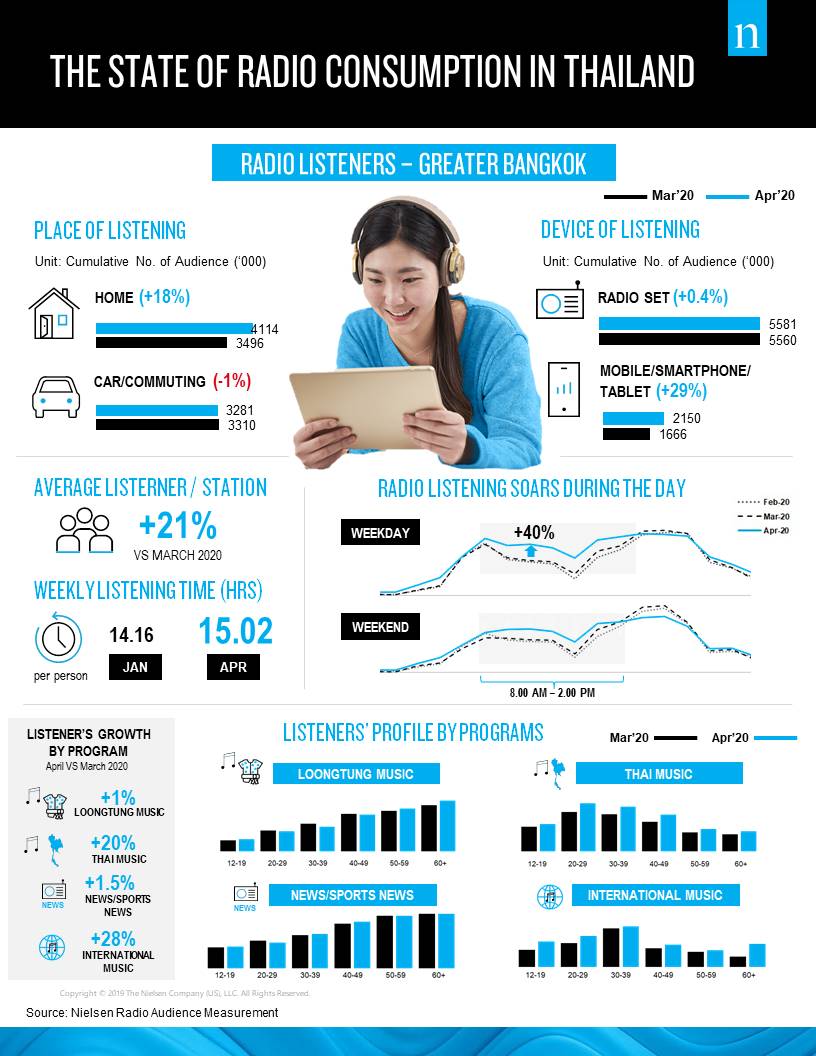Nielsen revealed the findings from the report, 'COVID-19 and the State of Radio Industry in Thailand,’ which analysed the impact of radio consumption among Thai consumers amidst COVID-19. The study was fielded with 1,650 audiences ranging from 12 years of age and above in the greater Bangkok area.
The data found that listeners were tuning in for almost an extra hour each week listening to the radio comparing January and April 2020, from an average of 14 hours 16 minutes per week to 15 hours 2 minutes per week, respectively. Additionally, the April data saw a rise in the average number of listeners per station with a growth rate of 21% compared to the previous month and an increase of 17% compared to the same month last year.
The current situation drove higher radio consumption at home with a growth of 18% where consumption in vehicles dropped by 1%. These figures suggested that the listening lost due to the reduction in commuting has been more than replaced by a boost in home listening. We also saw the growth of people listening via mobile/smartphone/tablet with a 29% increase. Nevertheless, the radio set was still the most popular device used among Thai consumers, with a growth rate of 0.4% comparing April and March data.
The Distinct Preferences in Different Profiles for Radio Consumption
Thai music programs (such as pop, rock, hip hop) and Looktung (Thai country music) were the two most popular programs, followed by news/sports news and international music programs. Although radio consumption surged in all the aforementioned programs, International music program and Thai music received the most benefit from this situation with 28% and 20% growth of listeners respectively.
Exploring further into the listener’s profile, the main audiences of all music programs (Looktung, Thai music, International music) were gearing towards female, whereas News and Sports News Listeners were gearing towards male. Nevertheless, the increase of radio consumption during COVID-19 can be seen from both male and female at a relatively similar growth rate for both genders in each program comparing April and March data.
Looking at the audience age profile, the report found Loongtung and News/Sports News attracted the attention of listeners aged 40 and above, while Thai and International Music were able to reach listeners under 40 years old better.
However, the increased listenership in each program was different and varies in each age range. For Looktung program, the highest growth of listeners centered on people age 60 years and above (+10%), News/Sports programs highest growth are people at the age of 40-49 years old (+4%), Thai Music program at 20-29 age group (+23%) and International music programs saw the highest increase in the number of listeners age 60 and above (+125%).
The Growing of Radio Listeners in Non-Prime Time
As people adjusted to spending more time at home, especially in April, radio consumption during the non-prime time was peaking, both weekday and weekend. During the workweek, the number of radio listeners increased markedly between 8:00 am - 2:30 pm with the highest growth rate (+40%) between 10:00-11:00 hrs. On weekends, however, listening soared at 8.00 am - 2 pm which was a half-hour shorter than normal days. Nevertheless, the prime time of radio consumption remained at 16.00 - 17.00 hrs across the whole week.
Even though more people were actively consumed radio content, like many other media, the radio ad experienced a fall in spending during the crisis. Spending on radio advertising drop 21% this year on April 2020 in comparison to last year, yet, we still saw brands from various industries (Finance, Supplement Products, Personal Care, Automotive, and Government Body) put their investment in a radio ad.
“Radio is another media that remains strong amid the pandemic as people’s 'newly working from home’ schedule are significant drivers of the increase in the hourly flow of listening throughout the day. That is why radio is an interesting option for marketers but, like any other Media, reaching the right audiences at the right time with the right content is crucial to ensure the optimization of their marketing effort,” said Aaron Rigby, Managing Director, Nielsen Media Thailand. “We also see significant growth in radio consumption through devices like smartphones and tablets. Media owners who are able to capture this opportunity; develop user-friendly platforms that cater to these devices and those who are able to maintain the additional audience base from this situation, even after the outbreak are those who will benefit from the situation.”
